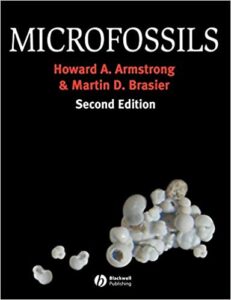By Howard A Armstrong and Martin D Brasier

The second edition of Microfossils, published in 2005, is still the definitive guide to all the major microfossil groups and the essential reference tool and laboratory guide for undergraduate and graduate students of micropalaeontology.
As it explains, there is now a greater understanding of the species and their stratigraphical ranges, along with advances in the completeness of the microfossil record and the advent of molecular techniques in classification. All of these have led to major changes in the classification and applications of microfossils.
Therefore, this new edition of Microfossils has been restructured and rewritten to take into account these significant advances to provide a complete guide to taxonomy, phylogeny, ecology and palaeoecology of microfossils and their applications.
Particular attention is given to the uses of microfossils in environmental reconstruction and biostratigraphy. Using numerous line and half-tone illustrations, there is an emphasis on practical applications of micropalaeontology and is certainly the only student-friendly micropaleontology text currently available.
An interesting review in Newsletter of Micropalaeontology in the year of book’s publication states:
If I were a student once again starting out in my micropalaeontological career, this would have to be on my shopping list…It is books like this that will hopefully catch the interest of undergraduates and persuade them to continue within the field and regenerate our ageing skills pool.”
In this respect, the new edition includes:
- Major revisions incorporating all the latest available research.
- A new section on isotopes, and on applications in stratigraphy, geothermometry and evolution.
- Coverage of the major developments in the use of microfossils in palaeo-oceanography and palaeoclimatology.
- Photographs to support the line drawings.
- Methods of extraction.
- A systematic index.
At the time of writing, Dr Howard Armstrong had been researching micropalaeontology for 20 years and had published extensively on applied micropalaeontology, numerical biostratigraphy, conodont palaeobiology and dispersal biogeography. His research focused on environmental and biological and biological patterns and processes associated with the Palaeozoic glaciations. He is currently a member of the Palaeoecosystems Group in Earth Sciences at the University of Durham.
Martin Brasier began research as a marine biologist about HMS Fox in 1970, mapping the microbial ecology of Caribbean reefs and algal mats. He was well known for his work on early biosphere evolution, integrating microfossils, biogeochemistry and chemostratigraphy from the earliest signs of life in the Archaean through to the Cambrian explosion of multicellular forms. He was Professor of Palaeobiology at the University of Oxford. Martin tragically died in a car accident in 2014.
Microfossils (2nd edition), by Howard A Armstrong and Martin D Brasier, Wiley-Blackwell (2005), 306 pages (paperback), ISBN: 978-06320527-9-0


